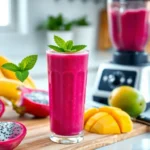We’ve all been there – rushing out the door with no time for a proper breakfast or desperately needing a post-workout fuel boost. That’s where our game-changing protein smoothie recipe comes to the rescue. This powerhouse blend delivers the perfect combination of muscle-building protein and energizing nutrients in just minutes.
What makes this smoothie stand out isn’t just its incredible taste – it’s the way it transforms your entire day. We’ve crafted this recipe to pack over 25 grams of protein while keeping the sugar content balanced and the flavor absolutely delicious. Whether you’re a fitness enthusiast or just someone who wants to feel more energized throughout the day this smoothie checks all the boxes.
The best part? You probably already have most of these ingredients in your kitchen right now. We’ll show you exactly how to blend up this creamy satisfying smoothie that’ll become your new go-to morning ritual or afternoon pick-me-up.
Ingredients
Our protein smoothie recipe relies on simple whole food ingredients that deliver maximum nutritional impact. These carefully selected components work together to create a creamy satisfying blend that fuels your body with essential nutrients.
Base Liquid Options
Dairy Options:
- 1 cup unsweetened almond milk (35 calories)
- 1 cup low-fat milk (110 calories)
- 1 cup Greek yogurt thinned with water (130 calories)
Plant-Based Alternatives:
- 1 cup oat milk (80 calories)
- 1 cup coconut milk unsweetened (45 calories)
- 1 cup soy milk unsweetened (80 calories)
Protein Powder Choices
Whey Protein:
- 1 scoop vanilla whey protein powder (25g protein)
- 1 scoop chocolate whey protein powder (24g protein)
Plant-Based Protein:
- 1 scoop pea protein powder (20g protein)
- 1 scoop hemp protein powder (15g protein)
- 1 scoop brown rice protein powder (22g protein)
Fruits and Vegetables
Fresh Fruits:
- ½ frozen banana (53 calories)
- ¾ cup frozen berries mixed (60 calories)
- ½ cup frozen mango chunks (54 calories)
Vegetables:
- 1 cup fresh spinach (7 calories)
- ½ medium avocado (120 calories)
- ½ cup frozen cauliflower (13 calories)
Healthy Fats and Add-ins
Nut Butters:
- 1 tablespoon natural almond butter (95 calories)
- 1 tablespoon peanut butter (90 calories)
- 1 tablespoon cashew butter (94 calories)
Seeds and Nuts:
- 1 tablespoon chia seeds (60 calories)
- 1 tablespoon ground flaxseed (55 calories)
- 2 tablespoons hemp hearts (85 calories)
Sweeteners and Flavor Enhancers
Natural Sweeteners:
- 1 teaspoon pure maple syrup (17 calories)
- 2-3 pitted Medjool dates (66 calories)
- 1 teaspoon raw honey (21 calories)
- ½ teaspoon vanilla extract
- ¼ teaspoon ground cinnamon
- 1 tablespoon unsweetened cocoa powder (12 calories)
- ½ teaspoon fresh ginger grated
Equipment Needed

Making our protein smoothie requires minimal kitchen equipment that most home cooks already own. We keep the preparation simple and efficient by using only essential tools that deliver consistently smooth results.
High-Speed Blender forms the foundation of our smoothie-making process. A powerful blender ensures proper mixing of protein powder while breaking down frozen fruits and vegetables into a silky texture. We recommend using a blender with at least 1000 watts of power for optimal performance.
Measuring Cups and Spoons provide the accuracy needed for balanced nutrition and flavor. These tools help us portion ingredients correctly, ensuring each smoothie delivers the promised protein content and taste profile. Standard measuring cup sets work perfectly for our liquid bases and larger ingredients.
Freezer Space becomes essential for storing frozen fruits and preparing ingredients ahead of time. We rely on frozen components to create the thick, creamy consistency that makes these smoothies satisfying. Proper freezer storage maintains ingredient quality and extends shelf life.
Refrigerator Storage keeps our perishable ingredients fresh and ready for blending. Cold ingredients blend more effectively and create a refreshing final product. We store Greek yogurt, fresh fruits, and prepared smoothie packs in refrigerated conditions.
Our equipment list stays intentionally minimal to encourage regular smoothie preparation. These basic tools enable us to create restaurant-quality protein smoothies at home without specialized or expensive equipment. The simplicity of our setup makes healthy nutrition accessible to everyone.
Instructions

Creating this protein-packed smoothie takes just minutes and requires only a few simple steps. We’ll guide you through the process to ensure you achieve the perfect texture and flavor every time.
Prep Your Ingredients
We start by gathering our base ingredients to create the foundation of our smoothie. Measure 1 cup of refrigerated milk, whether you prefer dairy or a non-dairy alternative like almond or oat milk. Add 1/2 cup of Greek yogurt, which can be either plain or flavored based on your preference.
Prepare 3/4 cup of fresh or frozen fruit such as berries, peaches, or melons. We recommend using 1/2 banana, either fresh or frozen, as it adds natural sweetness and creates a creamy texture.
For optional nutritional boosts, we can include spinach or power greens and chia seeds. Having all ingredients measured and ready ensures smooth blending without interruption.
Blend the Base
We begin blending by adding our liquid ingredients first to create proper flow in the blender. Pour the milk and Greek yogurt into a high-powered blender like a Vitamix for optimal results. Add the frozen fruit next, as this helps create the thick consistency we want.
Start blending on low speed and gradually increase to high. Blend until the mixture becomes smooth and uniform throughout. The initial blend should take approximately 30 to 45 seconds, depending on your blender’s power and the frozen fruit used.
Add Protein and Extras
We incorporate our protein powder at this stage to avoid clumping. Add 1 scoop of protein powder, whether whey, soy, or pea protein based on your dietary preferences.
For additional nutritional benefits, we can add 1 cup of spinach, which will change the smoothie’s color but won’t affect the taste significantly. Include 1 tablespoon of chia seeds for extra omega-3 fatty acids and fiber. Pulse the blender a few times to initially incorporate these additions before blending continuously.
Achieve Perfect Consistency
We use the blender’s tamper to push ingredients toward the blades for even mixing. This technique ensures all ingredients blend thoroughly without leaving chunks or powder pockets.
Pause the blender periodically to scrape down the sides with a spatula if needed. Add ice cubes one at a time if you prefer a thicker consistency or if using fresh fruit instead of frozen. Continue blending until the mixture reaches a smooth, creamy texture without any visible lumps.
Taste and Adjust
We taste the smoothie at this point to determine if any adjustments are needed. Blend again for 10 to 15 seconds if the flavor needs more integration.
Add honey, maple syrup, or your preferred natural sweetener if additional sweetness is desired. For enhanced flavor, consider adding a pinch of vanilla extract or cinnamon. Give the smoothie one final blend to incorporate any adjustments, ensuring the perfect balance of taste and nutrition.
Customization Options

We understand that everyone has different dietary needs and taste preferences when it comes to their protein smoothies. Our base recipe serves as the perfect foundation for countless variations that can accommodate exact nutritional goals and dietary restrictions.
High-Protein Variations
Boosting the protein content of your smoothie becomes simple with strategic ingredient swaps and additions. Our Workout Recovery Smoothie combines 1 scoop vanilla whey protein powder with ¾ cup fat-free milk, ½ ripe banana, ½ cup frozen raspberries, and ½ cup frozen blueberries for maximum post-exercise nutrition.
The Very Berry Super Shake takes protein to the next level by incorporating 2 scoops vanilla protein powder, 1 cup spinach, 2 cups frozen mixed berries, ½ cup plain low-fat yogurt, and 1 tablespoon walnuts. This combination delivers exceptional protein density while maintaining incredible flavor.
| Smoothie Variation | Protein Content | Key Ingredients |
|---|---|---|
| Workout Recovery | 25-30g | Whey protein, fat-free milk, berries |
| Very Berry Super Shake | 40-45g | Double protein powder, spinach, mixed berries |
| Basic Recipe | 20-25g | Yogurt, milk, protein powder |
Low-Carb Modifications
Reducing carbohydrate content requires thoughtful fruit selection and liquid base adjustments. We recommend replacing high-sugar fruits with lower-carb options like berries or citrus fruits that provide flavor without excessive natural sugars.
Switching from regular milk to almond milk or coconut milk significantly reduces the carb count while maintaining creamy texture. These plant-based alternatives offer fewer than 5 grams of carbohydrates per cup compared to dairy milk’s 12 grams.
Vegan and Dairy-Free Alternatives
Creating plant-based protein smoothies involves substituting all animal products with nutritious alternatives. We suggest using soy milk or almond milk instead of dairy milk to maintain protein content while avoiding lactose.
Replacing regular yogurt with soy yogurt or coconut yogurt provides probiotics and creaminess without dairy concerns. Plant-based protein powders like pea or hemp protein deliver complete amino acid profiles that rival traditional whey options.
Seasonal Fruit Combinations
Incorporating seasonal fruits ensures peak flavor and optimal nutritional value throughout the year. Summer brings us vibrant options like mango, peaches, or watermelon that add natural sweetness and hydration to smoothies.
Fall introduces warming flavors through apples, pears, or cranberries that complement protein powder beautifully. Winter citrus fruits like oranges, grapefruits, or pomegranates provide vitamin C and bright acidity that balances rich protein bases.
Spring welcomes us back to berry season with strawberries, blueberries, or raspberries that offer antioxidants and natural color. These seasonal rotations keep your protein smoothie routine exciting while maximizing nutritional benefits from fresh, in-season produce.
Storage and Make-Ahead Tips

Preparing protein smoothies ahead of time saves valuable minutes during busy mornings while ensuring we never skip our nutritional goals. Smart storage techniques help maintain optimal taste and nutritional value for days or even months.
Freezer-Friendly Prep Packs
We recommend portioning individual servings of frozen fruits and dry ingredients into freezer-safe bags or containers for ultimate convenience. These prep packs store beautifully in the freezer for up to 6 months without losing their nutritional benefits. When we’re ready to blend, we simply combine the pack contents with liquid ingredients and protein powder for an instant smoothie base.
Portion control becomes effortless when we prepare these packs in advance. We can create multiple flavor combinations at once, giving us variety throughout the week. Label each pack with the contents and date to track freshness and ensure we use older packs first.
Refrigeration Guidelines
Fresh protein smoothies maintain their best quality when stored in airtight containers in the refrigerator for up to 24 hours. We always use resealable containers to prevent oxidation and ingredient separation that can affect both taste and texture. For optimal flavor and nutrition, we consume refrigerated smoothies within 24 hours of preparation.
Airtight storage prevents the smoothie from absorbing other refrigerator odors while preserving the vibrant flavors we worked to create. We label our containers with the date and contents for easy identification, especially when preparing multiple smoothie varieties at once.
Best Serving Practices
Frozen smoothies require reblending upon thawing to restore their original creamy consistency. We can freeze smoothies in airtight containers for up to 3 months, making them perfect for long-term meal prep strategies. When ready to serve, we blend the thawed mixture briefly to eliminate any separation that naturally occurs during freezing.
Adding ice during reblending creates a thicker texture if desired, especially helpful when the smoothie has thinned during thawing. We serve our smoothies immediately after preparation or reblending for the most vibrant flavor and maximum nutritional impact.
Nutritional Benefits

Our protein smoothie delivers impressive nutritional value that supports your health goals throughout the day. We’ve crafted this recipe to provide approximately 329 calories and 21 grams of protein per serving, making it an excellent choice for muscle maintenance and recovery. The balanced macronutrient profile includes 26 grams of carbohydrates and 17 grams of fat, ensuring sustained energy without unwanted sugar spikes.
| Nutritional Component | Amount per Serving | Health Benefit |
|---|---|---|
| Calories | 329 | Sustained energy |
| Protein | 21g | Muscle maintenance |
| Carbohydrates | 26g | Quick energy source |
| Fiber | 5g | Digestive health |
| Fat | 17g | Nutrient absorption |
Vitamins play a crucial role in this smoothie’s nutritional profile. We incorporate ingredients rich in Vitamin C, Vitamin A, and B vitamins that support immune function, promote skin health, and boost energy production. These essential nutrients work together to keep your body functioning optimally while providing the fuel needed for daily activities.
Essential minerals found in our smoothie ingredients contribute significantly to your overall health. Calcium, magnesium, and potassium from sources like Greek yogurt, leafy greens, nuts, and seeds help maintain strong bones, support proper muscle function, and maintain healthy electrolyte balance. These minerals are particularly important for active individuals who need optimal muscle recovery.
Antioxidants present in the fruit components help combat oxidative stress throughout your body. We include berries and other antioxidant-rich fruits that may lower your risk of chronic diseases while supporting cellular health. This antioxidant protection becomes especially valuable when combined with regular exercise routines.
The high protein content serves multiple purposes beyond muscle support. We’ve designed this smoothie to promote satiety, helping you feel fuller longer and potentially supporting weight management goals. The combination of protein with fiber creates a satisfying meal replacement that can help control hunger between meals.
Healthy fats and fiber work together to provide sustained energy release. We include ingredients like almond butter and hemp seeds that contribute to feelings of fullness while supporting nutrient absorption. This combination helps prevent energy crashes and maintains stable blood sugar levels throughout your day.
The versatility of our protein smoothie allows for customization according to your exact dietary needs, preferences, or health goals. We can easily modify ingredients to accommodate various nutritional requirements while maintaining the core benefits that make this smoothie a practical option for quick, nutritious meals or post-workout recovery.
Troubleshooting Common Issues

Even the most experienced smoothie makers encounter challenges with texture, flavor, or nutritional balance. We’ve compiled answers to the most common protein smoothie problems to help you achieve perfect results every time.
Fixing Texture Problems
Watery smoothies often result from too much liquid or insufficient frozen ingredients. We recommend adding more frozen fruit or natural thickeners like nut butter, Greek yogurt, or rolled oats to achieve the ideal consistency. When your smoothie turns out too thick, gradually add more liquid until you reach the desired texture.
Foam and separation can make your smoothie less appealing and affect the drinking experience. Blend on low speed after finishing to reduce foam, and use frozen ingredients whenever possible since they create less air incorporation. Selecting creamy fruits like banana or mango helps prevent separation and maintains a smooth consistency throughout.
Achieving a perfectly smooth texture requires proper blending technique and ingredient ratios. Blend longer using a high-powered blender, ensuring you have sufficient liquid and frozen ingredients present for optimal mixing. We suggest following a 1:1 ratio of liquid to frozen ingredients for the best texture results.
Increasing creaminess becomes simple when you incorporate the right ingredients. Frozen bananas, mangoes, or pears provide natural creaminess while adding nutritional value. Greek yogurt, nut butter, or even avocado can transform a thin smoothie into a rich, satisfying drink.
Balancing Flavors
Sweetness adjustments require careful consideration of natural options over artificial sweeteners. Ripe bananas offer both sweetness and creaminess, while dates provide concentrated natural sugars with added fiber. A touch of honey can enhance sweetness when other ingredients fall short.
Combating bitterness often occurs when using certain greens or protein powders with strong flavors. Add creamy fruits or milk to counteract bitter notes, and consider incorporating a small amount of vanilla extract to round out harsh flavors. Plant-based milk alternatives can also help mellow intense tastes.
Saltiness should remain minimal in protein smoothies unless you’re creating savory varieties. Avoid adding salt unless absolutely necessary for flavor balance, and use savory ingredients sparingly to maintain the smoothie’s intended flavor profile.
Adjusting Protein Content
Increasing protein content requires strategic ingredient additions beyond just more protein powder. Greek yogurt provides both protein and creaminess, while nut butter contributes healthy fats along with additional protein grams. We recommend these natural protein sources for better taste and texture compared to simply doubling powder amounts.
Decreasing protein levels becomes necessary when smoothies taste too chalky or artificial. Reduce protein powder quantity or omit it entirely, relying instead on natural protein sources like yogurt, seeds, or nut butter for a more balanced nutritional profile.
Preventing protein powder clumps requires proper blending technique from the start. Blend protein powder with a small amount of liquid before adding other ingredients, ensuring complete dissolution and preventing lumpy texture that can ruin your smoothie experience.
Serving Suggestions

We recommend serving your protein smoothie immediately after blending for the best texture and flavor. Pour the smoothie into a tall glass or wide-mouth mason jar to showcase its vibrant colors and creamy consistency.
Glass Presentation Options
Transform your smoothie into an Instagram-worthy treat by choosing the right serving vessel. We prefer using clear glasses that highlight the beautiful layers when you incorporate colorful fruits like berries or tropical mangoes. Smoothie bowls offer another appealing presentation option, allowing you to create artistic designs with toppings while providing a more substantial meal experience.
Creative Topping Ideas
Enhance your protein smoothie with nutritious toppings that add texture and extra nutrients. We suggest sprinkling granola or crushed nuts on top for satisfying crunch. Fresh berries, sliced bananas, or diced seasonal fruit create visual appeal while boosting vitamin content. Chia seeds and hemp hearts provide additional protein and healthy omega-3 fatty acids.
Drizzle and Garnish Options
Elevate your smoothie presentation with strategic drizzles and garnishes. We recommend a light drizzle of natural almond butter or honey around the rim of your glass for added flavor complexity. Coconut flakes, cacao nibs, or a sprinkle of cinnamon can transform your basic smoothie into a gourmet experience.
Serving Temperature Tips
Serve your protein smoothie at the optimal temperature for maximum enjoyment. We find that smoothies taste best when served immediately after blending while they maintain their thick, creamy consistency. If your smoothie becomes too thin, add a few ice cubes and blend briefly to restore the perfect texture.
Portion Control Guidelines
Consider your nutritional goals when determining serving sizes. We recommend standard 16-ounce servings for meal replacement purposes, providing approximately 20-50 grams of protein per serving based on your ingredient choices. For post-workout recovery, smaller 12-ounce portions work well as a protein supplement rather than a full meal replacement.
Conclusion
We’ve shown you how simple it can be to create a delicious and nutritious protein smoothie that fits seamlessly into your daily routine. With over 25 grams of protein per serving and endless customization options this recipe adapts to your exact dietary needs and taste preferences.
The beauty of this smoothie lies in its versatility and convenience. Whether you’re meal prepping for the week ahead or need a quick post-workout recovery drink you now have all the tools and knowledge to succeed.
Start experimenting with different ingredient combinations and seasonal fruits to keep your smoothie routine exciting. Your body will thank you for the consistent nutrition and your taste buds will appreciate the variety. Here’s to making healthy eating both simple and delicious!
Frequently Asked Questions
What makes this protein smoothie recipe special?
This protein smoothie delivers over 25 grams of protein while maintaining balanced sugar content and great taste. It uses simple, whole food ingredients commonly found in most kitchens, making it accessible for anyone seeking a quick, nutritious meal option for breakfast or post-workout recovery.
What equipment do I need to make this protein smoothie?
You only need basic kitchen equipment: a high-speed blender for optimal mixing, measuring cups and spoons for accurate portions, freezer space for frozen fruits, and refrigerator storage for perishable ingredients like Greek yogurt. Most home cooks already own these essential tools.
How long can I store the prepared smoothie?
Refrigerated smoothies can be stored in airtight containers for up to 24 hours. For longer storage, prepare freezer-friendly prep packs with portioned ingredients that last up to six months. Remember to reblend frozen smoothies upon thawing to restore creamy consistency.
Can I customize this recipe for different dietary needs?
Yes, the recipe is highly versatile. For vegan diets, use plant-based milk and yogurt. For low-carb options, choose lower-sugar fruits and plant-based milk alternatives. You can also create high-protein variations by adding extra protein powder or Greek yogurt.
What are the nutritional benefits of this smoothie?
Each serving contains approximately 329 calories, 21 grams of protein, 26 grams of carbohydrates, and 17 grams of fat. It provides essential vitamins, minerals, and antioxidants while supporting muscle maintenance, sustained energy, and weight management through high protein content and healthy fats.
How do I fix common smoothie texture problems?
For thin smoothies, add more frozen fruits or ice. For thick smoothies, increase liquid gradually. Achieve creaminess by using frozen fruits and Greek yogurt. If your smoothie separates, reblend it. Always add liquids first, then frozen ingredients for better blending.
When is the best time to drink this protein smoothie?
Enjoy the smoothie immediately after blending for optimal texture and flavor. It’s perfect as a breakfast meal replacement, post-workout recovery drink, or nutritious snack. Serve in clear glasses or smoothie bowls with creative toppings for enhanced presentation and nutrition.







